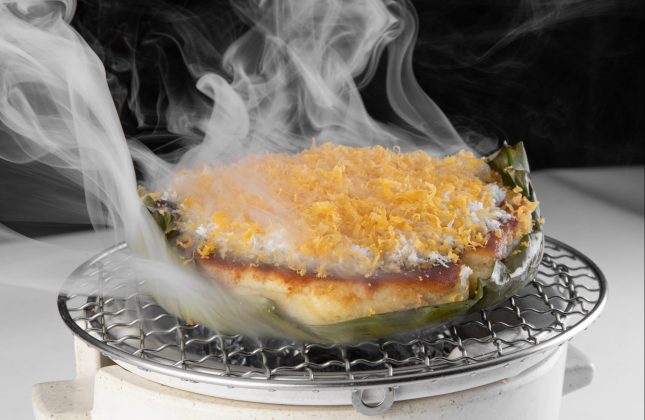A Filipino feast celebrates the good times ahead (hopefully)

By Joseph L. Garcia, Reporter
FOR those of us who have been making do with our own subpar home cooking and food deliveries which never quite arrive at the right temperature during this pandemic, a rare dinner invitation is always welcome (provided that it’s safe).
Last week, BusinessWorld was invited for dinner at Haliya, a new Filipino restaurant by Nuwa at the City of Dreams. The restaurant’s name is of a good omen: Haliya is a pre-colonial moon goddess, with a face so beautiful it had to be covered with a mask of gold. In legend, she wages war on the Bakunawa, a sea serpent that consumed her brother, the moon god Bulan. When every day is a battle, it’s nice to have a goddess backing you up.
When asked why they opened a new restaurant during the pandemic, Charisse Chuidian, Vice-President of Public Relations for City of Dreams said, “If it was a gamble, it was a very good gamble. I think it paid off.” Appropriate words from the property, whose casino now operates at about 50% capacity. The indoor restaurants, meanwhile, such as Haliya, operate at 40% capacity. “We went by customer feedback, and it seemed that there’s a high percentage wanting a dedicated Filipino restaurant,” she said, adding that they would also open a Korean, Japanese, and a Singaporean seafood restaurant in the near future.
The inconveniences that defined our lives before the pandemic have slowly been trickling back since the loosening of restrictions due to the decline of COVID-19, such as the traffic along EDSA. This is peppered with the minor sacrifices the pandemic taxes from us: for example, tinted face shields are not allowed at the City of Dreams, but what is elegance but the elimination of inconvenience? They had clear, clean, brand-new face shields at the door. Sanitizers were at every entrance (though not at every table), and masks were kept mostly on by other diners (who have to present vaccination cards upon entry to the restaurant). The staff kept their whole kit on: masks and face shields, and were very attentive throughout the evening.
NOW, FOR THE FOOD
Chef de Cuisine Edmundo San Jose worked in the Middle East until 2016. Used to the intensity of world cuisine, this restaurant (which used to be the Crystal Lounge, a very fine bar) reflects his journey home. “Doon ko na-realize na talagang mas gusto ko siyang kainin (That’s where I realized that that’s what I wanted to eat),” he said, speaking of the tastes of home. “Pag nag-day-off ako talaga ako, iyon na mismo ang ginagawa ko (On my days off, that’s what I really do).”
The chef infuses his foreign experiences into Filipino cuisine, presenting something new and familiar at the same time. For example, he takes a seafood lumpia (spring roll; P980) and presents it in the shape of a tart. It’s filled with lobster and crab, with a crystallized malunggay (moringa) chip, and dipped in calamansi aioli-aligue (local citrus and crab fat) dip. The freshness of the seafood made me think of vacations spent by some of our nation’s better shores. An accompanying dish of oysters (P500), served raw with finger limes and avocado crema, had an aggressive taste of the sea, and the oysters felt as if they were still bursting with seawater.
A pea and malunggay soup (P300) reminds one comfortably of local mongo guisado (mung bean soup), what with bits of lechon (roast pig) skin in it (much like you’d add chicharon — cracklings — to your own mongo). Everybody looked in awe at an adobo (a vinegar braised protein, P1,250) — for it had been served with just-right foie gras. The foie gras, just very slightly flavored with the thick, caramelized adobo sauce, instructs one to savor it as an experience, thus guiding your tongue to appreciate the careful braising that led to a rich sauce and very tender chicken.
Another dish, a kare-kare (a peanut-based stew; P980) was made with 24-hour slow cooked US Angus beef brisket, asparagus, baby Baguio petchay (Chinese cabbage), crispy fried baby eggplants, roasted and crushed peanuts, and bagoong (shrimp paste). A knife cut through the beef like butter, while the silky sauce, despite its cosmopolitan companions, tastes like something made with love by one of your own beloved relatives. All this and more, of course, was served with generous servings of rice (it was a Filipino feast, after all).
Dessert included a Chichingka, a cheesecake and bingingka (rice cake) hybrid, made with salted eggs and toasted coconut, served on a tiny little ceramic stove that gave a puff of smoke when attendants dripped a little vanilla scent into it. It tasted rich and creamy, and was much too heavy for all of us at the table, stuffed to the gills as we were.
FRESH FROM THE SOURCE
Mr. San Jose sources most of his ingredients locally: his oysters, for example, were sourced from Caticlan. His most challenging dish, for him is the paksiw (fish braised in vinegar), carefully poached and sitting on a bed of adlai grains.
Speaking of his many seafood selections, he said, “Talagang mga Pilipino kasi, normally, more tayo sa seafood eh. Mas madali syang i-source (Filipinos really are more into seafood, and it’s easier to source).”
He also added that he’s taking advantage of the location’s proximity to the sea, therefore allowing for fresher seafood. Despite access to some of the world’s best, all the time, he says, “As a Filipino (restaurant), kailangan local rin ang gamitin natin (we still need to use local ingredients).”
For most of us who have been reacquainted with our stoves during the pandemic, the prospect of Filipino food might have seemed banal. The magic of Haliya, however, was to take familiar elements of what we already have and transform it into something luxurious and yet somehow still familiar. The sensation would be akin to the stepsisters meeting Cinderella at the ball, after they had just seen her face in their kitchen.
Speaking of people rushing home before midnight, we ended the dinner by 11 p.m. (the end of the metropolis’ curfews took effect that midnight). These had been the people who had known dinners that went on into the wee hours of the morning. Our stomachs had shrunk — perhaps because the months in isolation had removed the reason for and the memory of feasting. It seems almost fitting, then, for this restaurant, in one of the city’s most luxurious properties, to serve Filipino food in this luxurious manner: it’s an invitation to a promise of lost abundance; a faith and pride in who we are, and what we can still do.
Haliya is open daily for dinner from 5 p.m. to 11 p.m. Reservations are encouraged due to limited seating and restricted capacities for indoor dining. For inquiries and reservations, call 8800-8080 or e-mail guestservices@cod-manila.com or visit www.cityofdreamsmanila.com.




